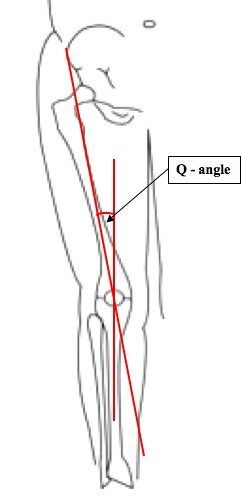
Q Angle and Knee Pain
The Q angle describes the angle of the knee from a frontal view. It gives an idea of how the thigh muscles functions to move the knee and also how the knee cap (patella) tracks in the groove of the knee joint. A normal knee cap should move up and down within the groove with flexion and extension of the knee. When the Q angle is excessive, the knee cap tends to track out of alignment and hence causes wear and tear (degeneration) of the cartilage behind the knee cap.
What is the normal Q angle?
The normal q angle measured in standing is about 15 degrees and anything more than that is considered a risk factor for knee injuries. Ladies tend to have a wider Q angle due to their wider pelvis compared to their males. From some studies, 13.5 ± 4.5° is considered as a normal Q angle for healthy subjects between the ages of 18 and 35 years.

How to measure the q angle?
The Q angle is an intersection of two lines. The first line joins the ASIS (bony protrusion in the front of the pelvis) to the middle of the patella. The second line runs from the protrusion on the top of the shin bone (tibial tuberosity) below the patella and upwards through the middle of the knee cap.
Common injuries related to a wide q angle:
- Iliotibial band friction syndrome (ITBFS)
- Anterior knee pain or Patella Femoral Pain Syndrome (PFPS)
- Anterior cruciate ligament injury (ACL)
Types of injuries from an excessive Q angle
Injuries because of an excessive Q angle can be categorised into 3 main reasons.
1. Muscle imbalance
A large Q angle pulls the knee cap outwards due to the stronger lateral pull from the quadriceps and tight ITB. Coupled with a weakness of the inner aspect of the quadriceps (Vastus Medialis Oblique, VMO) the knee cap will track laterally instead of smoothly up and down within the knee groove. This maltracking causes the cartilage behind the knee to wear off or degenerate and hence the pain.
2. Biomechanical compensation
An excessive Q angle can alter the movement pattern, especially in the foot. The knee will tend to point inwards (valgus or knock-knee appearance) which encourages the foot to roll inwards (pronates). Over-pronation can lead to a number of injuries, especially in runners.
3. Joint laxity/instability
When the knee point inwards, the ligaments on the inner aspect of the knee gets overstretched and lax, therefore compromising the stability of the knee joint. The Anterior Cruciate Ligament (ACL) also undergoes a lot of stress in this position. Interestingly the larger Q angle in females has been attributed as the main reason why females are at a higher risk of sustaining an ACL injury.
How to manage a wide Q angle?
You can reduce the risk of injuries by targeting the reasons above.
1. Muscle imbalance correction
Stretching on the ITB, strengthening the VMO and Glut medius to enable proper tracking of the knee cap to mitigate the maltracking from a wide q angle.
2. Biomechanics correction
Get a customised orthotics to control excessive pronation and reduce the stress to the knee.
3. Joint Laxity/Stability correction
Balancing exercises to train knee proprioception and stability.
Experiencing knee pain? Click here to find out more about physiotherapy for knee pain relief and how Core Concepts can help
Related Articles
- PFPS- Knee pain: Cause and solution! If you notice a gradual dull aching sensation in the knee with intermittent sharp pain especially with negotiating stairs,…
- Knee Pain: Fat Pad Irritation or Hoffa’s Syndrome Fat pad irritation (Hoffa’s syndrome) is a condition that falls under the broad umbrella of knee dysfunction leading to…
- Chronic Low Back Pain: Bio-Psycho-Social Model In… Low back pain is termed chronic when the pain lasts for more than 3 months. The literature and clinical practice…
- Patella Tendinopathy: A pain in the knee Patella tendinopathy, or jumper's knee, is a condition that results from an inflammation and/or overload of the patella tendon.…
- Osteoarthritis: All your burning questions answered… In celebration of World Arthritis Day, we'd like to play our part in raising awareness for Osteoarthritis - the most…
